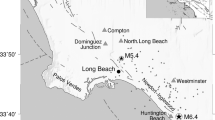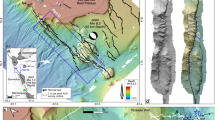Abstract
THE amplification of ground motion by low-seismic-velocity surface sediments is an important factor in determining the seismic hazard specific to a given site. The Ms = 7.1 Loma Prieta earthquake of 17 October 1989 was the largest event in the contiguous United States in 37 years, and yielded an unparalleled volume of seismic data from the main shock and aftershock sequence1. These data can be used to image the seismic source, to study detailed Earth structure, and to study the propagation of seismic waves both through bedrock at depth and through sediment layers near the surface. Near the edge of San Francisco Bay, site conditions vary considerably on scales of hundreds of metres. The collapsed section of the two-tiered Nimitz Freeway in Oakland was built on San Francisco Bay mud, whereas stiffen alluvial sediments underlie a southern section that was damaged but did not collapse. Here we analyse high-quality, digital aftershock recordings from several sites near the Nimitz Freeway, and conclude that soil conditions and resulting ground-motion amplification may have contributed significantly to the failure of the structure.
This is a preview of subscription content, access via your institution
Access options
Subscribe to this journal
Receive 51 print issues and online access
$199.00 per year
only $3.90 per issue
Buy this article
- Purchase on Springer Link
- Instant access to full article PDF
Prices may be subject to local taxes which are calculated during checkout
Similar content being viewed by others
References
Earthquake Engineering Research Institute, Preliminary Reconnaisance Report, Loma Prieta Earthquake. October 17, 1989 EERI89-03, 51 pp. (1989).
Borcherdt, R. D. Bull. seism. Soc. Am. 60, 29–61 (1970).
Milne, J. Seismology, 1st edn 320 pp. (Kegan Paul, Trench, Truber, London, 1898).
Wood, H. O. Carnegie Inst. Washington Publ. 87, 220–245 (1908).
Singh, S. K. et al. Earthquake Spectra 4, 653–673 (1988).
Lermo, J., Rodriguez, M. & Singh, S. K. Earthquake Spectra 4, 805–814 (1988).
Borcherdt, R. D. U.S. Geol. Surv. Prof. Paper 941-A (1975).
Borcherdt, R. D. & Gibbs, J. F. Bull. seism. Soc. Am. 66, 467–500 (1976).
Rogers, A. M., Tinsley, J. C. & Borcherdt, R. D. U.S. Geol. Surv. Prof. Paper 1360, 221–248 (1985).
Nims, D. K., Miranda, E., Aiken, I. D., Whittaker, A. S. & Bertero, V. V. Rep. UCB/EERC-89/16 (1989).
Borcherdt, R. D., Gibbs, J. F. & Lajoie, K. R. U.S. Geol. Surv. Map MF 709 (1975).
Author information
Authors and Affiliations
Rights and permissions
About this article
Cite this article
Hough, S., Friberg, P., Busby, R. et al. Sediment-induced amplification and the collapse of the Nimitz Freeway. Nature 344, 853–855 (1990). https://doi.org/10.1038/344853a0
Received:
Accepted:
Issue Date:
DOI: https://doi.org/10.1038/344853a0
This article is cited by
-
Evaluation of seismic hazard in the central seismic gap region of Himalaya based on site effects and simulated accelerograms
Acta Geophysica (2024)
-
Simulation of strong ground motions from 2016 Kumamoto (Mw 7.1), Japan, earthquake using modified hybrid technique
Arabian Journal of Geosciences (2024)
-
The 2023 Turkey–Syria Earthquake Sequence: Ground-Motion and Local Site-Effect Analyses for Kahramanmaras City
International Journal of Civil Engineering (2023)
-
Characteristics of site-specific response using the measured data from seismic accelerometers in Pohang Yeongil New Port under 9.12 and Pohang earthquakes
Scientific Reports (2022)
-
Estimation of site response functions for the central seismic gap of Himalaya, India
Natural Hazards (2021)
Comments
By submitting a comment you agree to abide by our Terms and Community Guidelines. If you find something abusive or that does not comply with our terms or guidelines please flag it as inappropriate.



